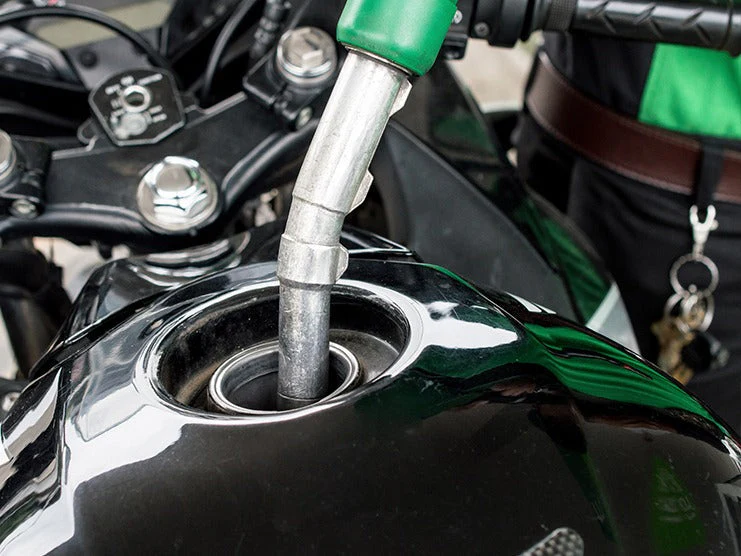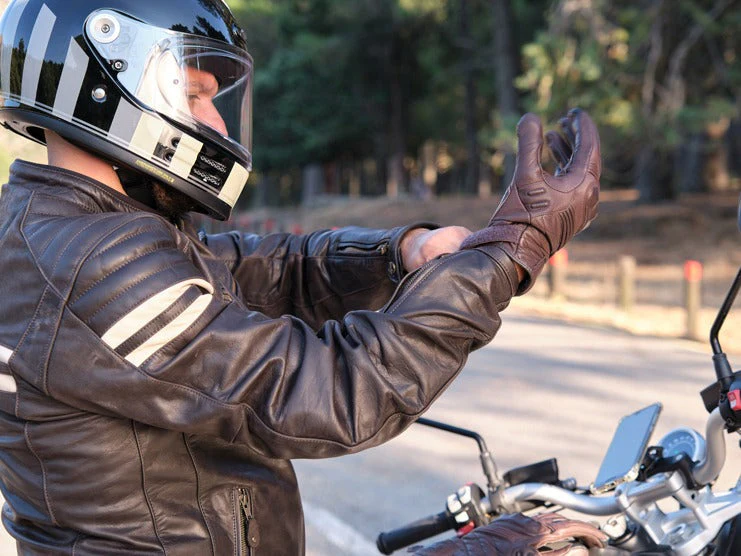Motorcycle riders need to pay attention when refueling their rides. The kind of fuel you use for your motorcycle will affect the engine's performance and longevity. Using the wrong fuel for your motorcycle can result in reduced engine efficiency, shorten the engine’s lifespan, and damage internal engine parts.
This article will explain what happens if you refuel your motorcycle with the wrong gas and what type of fuel you should or shouldn’t use for your motorcycle.
Table of Content
1. What is the Octane Number?
The octane number measures the performance of different types of fuels. It measures the ability of the fuel to resist compression in an internal combustion engine. It doesn’t really increase the motorcycle’s horsepower or torque but helps with the gas’s resistance to knocking and the engine’s performance. The octane number is important since most motorbikes have high-compression engines.
When you ride a motorcycle at high rpm, you may frequently hear a knocking sound from the engine; this sound is either the piston at the bottom of the engine hitting the cylinder wall or the piston hitting the valve. A high-octane fuel will reduce the knocking sound better than a low-octane fuel.
On the pump, the ratings are listed from lower to higher octane from left to right. The higher the octane number, the more pressure can be applied without the fuel mixture exploding. It is important to match the octane number with the engine's compression to ensure the engine functions correctly.
2. The Right Gas for Motorcycles
Higher octane gasoline without ethanol is intended for motorcycles. Because ethanol is a fuel additive that raises the octane in gasoline, it is important to utilize ethanol-free gasoline for motorcycles with carburetors.
At over 90% of petrol stations, ethanol is found in almost all fuel. That is why many fuel pumps have a sign that reads, "May Contain Up to 10% Ethanol."
2.1 Types of Gas
Regular Gas
Regular gas has octane numbers ranging from 85-88, and it’s typically the cheapest gas available at fuel pumps.
Mid-Grade Gas
Mid-grade gas has octane numbers ranging from 89-90, offering a high level of performance, but still isn’t the best option for high-performance motorbikes requiring premium gas.
Premium Gas
Premium gas is the highest quality fuel with an octane number of 92 and is suited for high-performance vehicles.
3. Putting the Wrong Gas in a Motorcycle
If you put the wrong gas in your motorcycle’s fuel tank, the following will occur:
- If your motorcycle has a four-stroke engine and can only handle premium quality gas, but you accidentally fill it with regular fuel, there wouldn’t be any significant effects, except you’ll hear knocking sounds coming from the engine. Over time, you’ll notice a slight drop in engine performance, but your motorcycle will still be able to continue running.
- A two-stroke engine may start to knock if you try to use fuel with an octane rating lower than 90. The knocking sound is due to the gasoline igniting in the motorcycle's cylinder earlier than it should. Avoid riding your bike if there is a knocking sound since doing so may cause further damage to the internal engine parts. When the engine is under stress, the knocking sound is at its loudest.
- If you use premium quality fuel for a motorcycle designed to run on a lower octane fuel, it won’t damage the internal of your motorbike. All you will do is waste money buying fuel that will not improve performance.
3.1 Ethanol Fuel
All fuels contain ethanol to some degree. However, fuel stations that provide fuel with higher levels of ethanol tend to be much cheaper than other types of fuel.
Ethanol may clog on carbureted motorcycles since they tend to build up in small, compact parts like the carburetor. If you have a fuel-injected motorcycle, ethanol is less likely to build up.
Modern motorcycles tend to be fuel-injected and have a high compression ratio. It is best to use non-ethanol premium gas for these vehicles.
It is risky to use ethanol for two-stroke motorbikes like dirt bikes. Higher ethanol levels will break down fuel, reducing lubrication and resulting in the engine becoming damaged.
For four-stroke motorcycle engines, pouring in ethanol is relatively safer. For four-stroke motorcycles, fuel and oil are not combined. Hence, oil cannot be broken down by ethanol. Your motorcycle can operate on ethanol-based fuels and has an oil reservoir.
But avoiding ethanol-based fuels can help minimize corrosion and clogging in two-stroke, four-stroke, carbureted, and fuel-injected motorcycles. If you must use ethanol, use it sparingly at about 10% or less.
3.2 Diesel
It is not recommended you pour diesel into your motorcycle since they have different properties from gas and are intended for different vehicle engines. However, there are a few dirt bikes that can run on diesel.
Your motorcycle might not start if you pour diesel into it. Even if it does, it will probably emit a lot of smoke from the exhaust and quickly lose power. When you're riding, it can even stall or discharge flames from the exhaust, which is extremely dangerous and might even cause a brush fire.
Turn off the engine and drain the fuel tank as quickly as you can if you mistakenly pour diesel into your gasoline-powered motorbike.
3.3 Unmixed Gas
Compared to four-stroke models, two-stroke dirt motorcycles are more sensitive to fuel adjustments. Two-stroke engines need a pre-made gasoline and oil mixture, but four-stroke engines can operate only on gas directly from the pump. The extra oil ensures that the engine is lubricated and operates smoothly.
Two-stroke dirt bike owners often purchase gasoline and oil separately before mixing in the recommended ratios to ensure the engine is lubricated while running. Running a two-stroke engine on just gasoline will not lubricate all the engine parts, which can lead to overheating and the engine seizing.
Riding a two-stroke motorcycle with unmixed fuel could damage the cylinder, piston, and other parts, which can result in loss of compression and engine failure.
If you have accidentally filled your two-stroke motorbike with unmixed fuel, it’s best to drain the fuel tank and refill it with mixed gas. Turn off the bike and give the engine time to cool. Next, create a proper fuel mixture, with a few drops of oil required per gallon of fuel.
3.4 Incorrectly Mixed Fuel
Two-stroke engines require the fuel to be premixed with the oil, while four-stroke engines have an oil system that applies oil directly to the parts that require lubrication. If motorcycle riders put the wrong fuel-to-oil ratio in their two-stroke bikes, the following scenarios may occur:
- Low Gas-to-Oil Ratio: Riding a two-stroke motorcycle with fuel that has a low gas-to-oil ratio (too much oil and not enough gas) will lead to smoke billowing from the exhaust, but this won’t cause any long-term damage to the motorbike.
- High Gas-to-Oil Ratio: Riding a two-stroke motorcycle with fuel that has a high gas-to-oil ratio (too much gas and not enough oil) can potentially damage the motorcycle’s internal parts.
- Mixed Two-Stroke Gas in a Four-Stroke Engine: Mixing two-stroke fuel in a four-stroke engine won’t cause long-term damage, but will result in more smoke from the exhaust and poorer performance. This can lead to oil leaks and grease buildup inside the engine.
3.5 Mixing Premium and Unleaded Gas

It’s safe to use a mixture of premium and unleaded gas unless your motorcycle is only meant to use high-octane gas. But if you pour this mixture into a bike that uses premium quality gas, it will result in reduced engine performance and could damage the engine’s internal parts.
However, it is well-suited for bikes that don’t require high-octane fuel since it has fewer chemicals than other fuel mixtures.
If mid-grade fuel is not available at your local fuel pump, you can make your own blend by using premium and unleaded gas. The resulting mid-grade fuel will help reduce knocking in your motorcycle.
3.6 Oil
If you accidentally pour too much oil into the fuel tank, it may damage the fuel pumps and engine sensors, and block the injectors. The engine will stop if too much oil gets into the fuel tank. You will have to thoroughly clean the fuel system and even replace parts like the catalytic converter and sensors.
4. What Kind of Fuel Should You Not Use for Your Motorcycle?
- Low-Octane Fuel: Avoid using fuel that has an octane rating lower than what is recommended by the manufacturer. Low-octane fuel may combust even before the spark plug generates a spark, which can cause the engine to become unstable.
- High-Octane Fuel: Fuel with a higher octane number is more expensive and will only benefit high-performance motorcycles.
- Fuel with High Ethanol: Do not use fuel with more than 10% ethanol as it can damage your motorcycle’s fuel line and engine.
- Diesel: Do not pour diesel into your motorbike unless it is built to run on diesel.
5. What to Do if You Accidentally Fill Your Motorcycle with the Wrong Gas?
It is best to drain the fuel tank, clean the fuel system, and refill with the correct gas if you accidentally pour the wrong gas into your motorcycle.
Follow these steps to drain the fuel tank:
- Step 1: Close the petlock, a valve on the bottom of the fuel tank. There’s also a reverse position so make sure to keep the petlock closed.
- Step 2: To drain the fuel tank, place the container below the fuel line and remove the fuel line from the carburetor. Let the fuel drain out completely.
- Step 3: Drain the carburetor if your motorcycle has one. Open the drain plug at the bottom of the float bowl in the carburetor and drain it completely.
- Step 4: Fill the fuel tank with the right fuel. Before filling, make sure that the fuel line and drain plug are secured.
6. Last Words
You may have accidentally filled your motorcycle’s fuel tank with the wrong type of gas. Motorbikes constantly filled with the wrong types of fuels may produce knocking sounds and excessive smoke.
Furthermore, it may also cause internal engine problems due to the fuel-air mixture prematurely igniting. If you would like to improve your motorcycle's overall look and luggage storage capacity then you can install new Saddlebags, Sissy Bar Bags, Tank Bags, fairings, handlebars, seats, crash bars, luggage racks, and sissy bars.
























Leave a comment
All comments are moderated before being published.
This site is protected by hCaptcha and the hCaptcha Privacy Policy and Terms of Service apply.